What is Circuit Breaker?
A circuit breaker is nothing but a mechanical switching device which has capable of carrying and breaking the current for the specified time. The circuit breakers are classified based on the types of arc quenching medium used in it.
Types of Circuit Breaker
There are 9 types of circuit breakers are in service based on insulating medium use it for the arc quenching mechanism.
- Air Break Circuit Breaker
- Air Blast Circuit Breakers
- Oil circuit breakers
- Minimum Oil circuit breaker
- Vacuum Circuit Breakers
- Miniature Circuit Breakers
- SF6 Circuit Breakers
- Earth Leakage Circuit Breakers
- HVDC Breakers
Before brief looking just understand the types of circuit breaker and it is operating voltage and current range.
| Types | Voltage Level | Current Rating |
| ACB | 690 | 4000A |
| ABCB | 735kV | 6300Amps |
| BVOCB | 66kV | 6300 Amps |
| MVOCB | 66kV | 6300 Amps |
| SF6 | 1200 kV | 6300 Amps |
| VCB | 66kV | 4000 Amps |
| MCCB | 440V | 630Amps |
| MPCB | 690 V | 120Amps |
| MCB | 440v | 100 Amps |
| ELCB | 440V | 63A, 300mA |
| RCCB | 440V | 63A, 30mA |
Note: Above rating can be varied between the manufacturer.
Air break Circuit Breakers:
ACB is a short form of Air Break Circuit Breaker. They are employed for the voltage up to 690V applications and the current ranging from 100 Amps to 4000 amperes and the braking capacity of 80-kilo amperes.
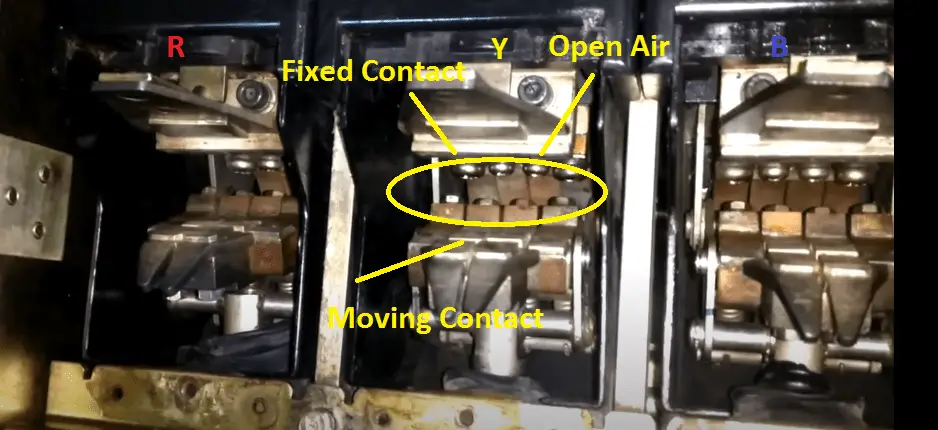
These types of circuit breaker use open the air as arc quenching mechanism at normal temperature and pressure (Look at the above image). Note that, an air blast is different and air break is different and it works at normal pressure and temperature.
Air Break Circuit breaker has inbuilt thermal overload release, that means the release is due to the heating caused by the overload so we do not require any external relay for the tripping signals. The internal relay will get the power supply from the circuit breaker.
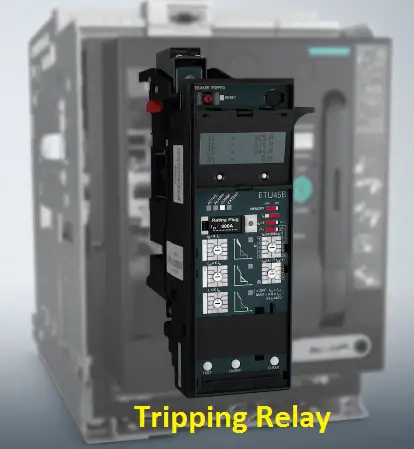
It has a high speed of operation on short circuit conditions and overload release.
Also, we can adopt extra function for the shunt trip, remote trip/close and under-voltage release. But they are optional and you can reject them while buying a circuit breaker. In case if you need them in feature, then you can adopt it. Also, It requires an external power supply. Example: Siemens 3 WL model.
Air Blast Circuit Breaker:
A compressed air/gases are used as arc quenching medium, the gasses may be the carbon dioxide, nitrogen, Freon or hydrogen. But compressed air has more financial and technical advantages than the above gases.
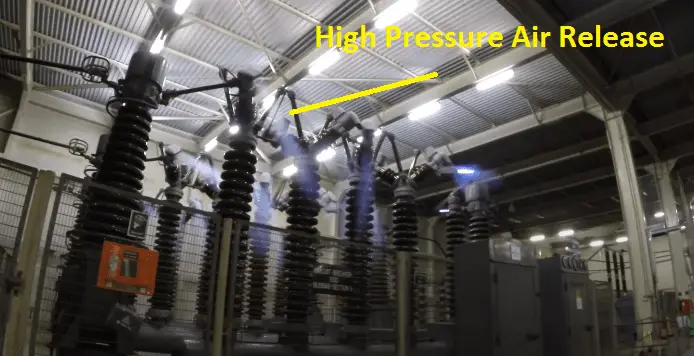
During tripping the circuit breaker, the compressed air pushes the breaker moving contacts, blows the ionized gas (free electron) from the main contact’s chamber.
Working principle of Air Blast Circuit Breaker:
Based on the contact position, the Air blast circuit breaker is divided into three types such as,
- Axial blast Air Circuit Breaker: The air blast is directed to longitudinal along with arc.
- Cross Blast Air Circuit Breaker – Air blast is directed at right angles to the arc.
- Radial Blast Air circuit breaker – Airblast is directed radially.
In earlier days, they used up to 22kV. But now a day they are implemented above 220kV to 735kV voltage level.
Live Operation of 275kV Air Blast Circuit Breaker:
It has many advantages such as
- High-speed tripping with the compact size.
- Less maintenance, since the compressed air clean the contacts.
- Long Life than air break type circuit breaker.
- Fire Free
Bulk Oil Volume Circuit Breaker:
Bulk oil volume circuit breakers, as the name says oil, here it is used for insulating and for arc quenching. The Mineral oil or transformer oil is used for arc quenching. Look at the image of bulk oil volume circuit breaker contacts.
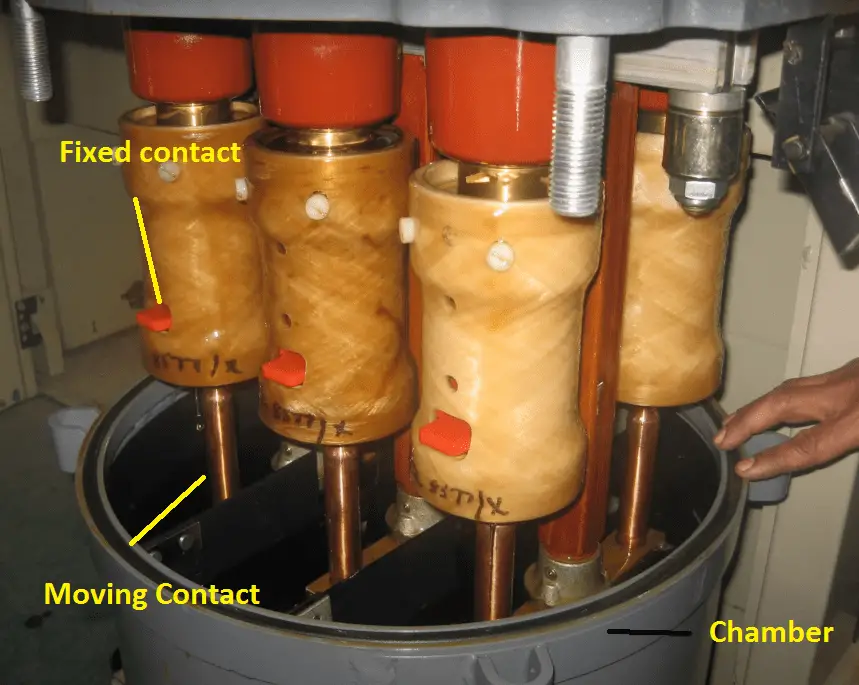
These actually are obsolete today; obsolete that means they are not much in use today or they have become outdated but you can find their existence in older substation installations. They are existence at the oldest obsession installations, but you must know the working principle of these circuit breakers.
Let us consider a protective relay provides a tripping signal to the bulk oil volume circuit breakers. Hence the circuit breaker contacts will be opened, so there will be arcing. Due to this arcing the decomposition of the oil takes place.
As you know, the oil contains hydrocarbon organic chemical material; due to arcing decomposition of this oil occurs and it will generate hydrogen. Now, this hydrogen has two important uses one is it works as a coolant and it has high dielectric strength.
Next coming to the tank part, the tank is connected with the earth terminal.
Minimum Oil Volume Circuit Breaker.
Look at the above bulk oil type of circuit breaker, in that the total volume of oil is used for both quenching and insulation. The level of insulating oil volume also simultaneously reduced.
In order to overcome that, the minimum oil circuit breaker is implemented. Here the insulating oil and quenching oil is separated by the different chamber. Hence insulating do not contribute for arc quenching and it won’t deterioration.
It is used up to 66kV voltage level.
Also, the tank will be connected with the live terminal, it acts as a terminal block.
SF6 Circuit Breaker:
The sf6 circuit breaker and sulfur hexafluoride circuit breaker these are the most popular circuit breakers in which SF6 gas is used as arc quenching medium.
Sf6 gas has high dielectric strength & electronegative property. So that the arching electrons get attached to these sf6 molecules and this property helps in the faster recovery of the dielectric strength. Look at the inner view of SF6 circuit breaker,
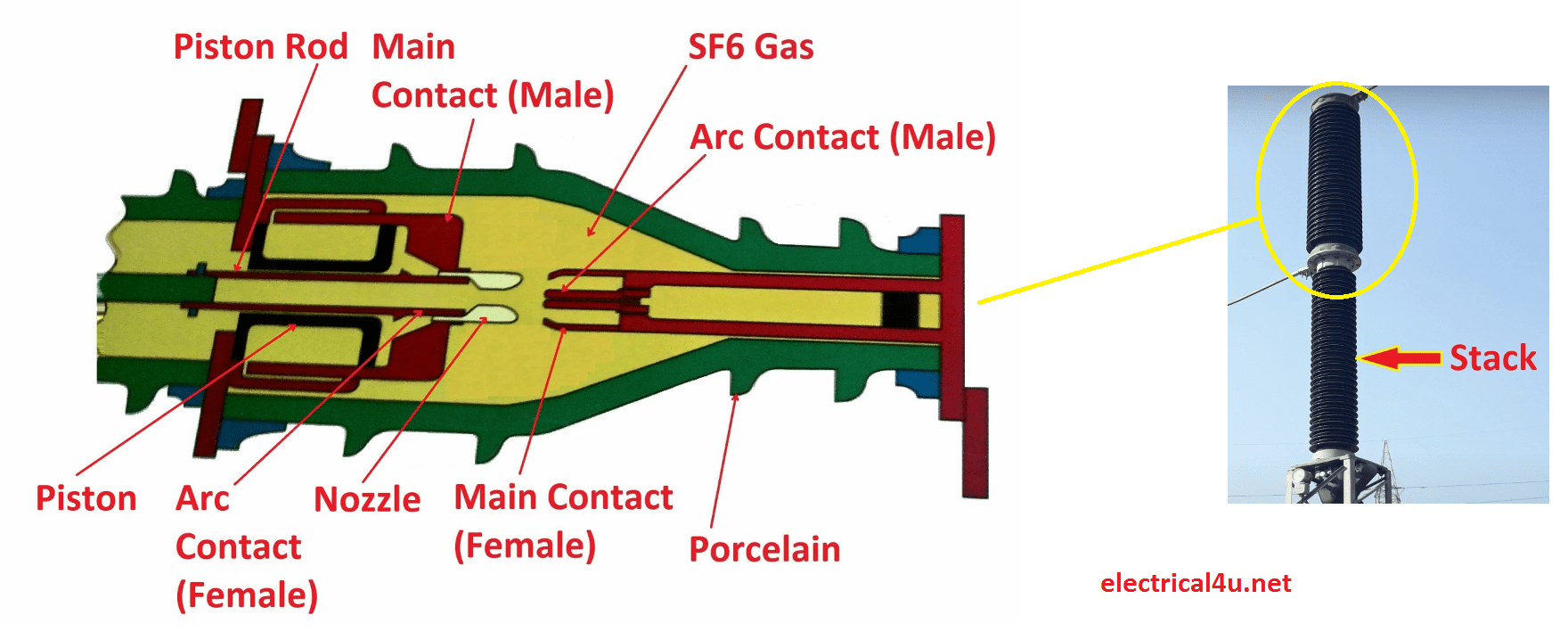
As you know, the arc is a call of ionized gases and these ionized gases contain the electrons and the ions. If you combine these electrons and ions into neutral molecules, then there will be no electrons present in the medium and there will be no conducting channel so that is what we are saying here once the electrons get attached it to the sf6 molecules there won’t be any ionized gases in between the fixed corner and the moving content.
The SF6 circuit breaker is used from 6.6kV to 735kV voltage level.
Vacuum Circuit Breaker:
The vacuum is used as an arc quenching medium in vacuum type of circuit breaker. As you know the vacuum does not allow free electron. Hence while opening a circuit breaker under fault condition, the free electron being developed will be restricted or quickly extinguished.
10-6 torr vacuum pressure will be maintained inside the chamber. Vacuum circuit breakers are used up to 66kV voltage level for both indoor and outdoor application.
Some other low voltages and low current circuit breakers are
- Earth leakage circuit breaker: Use to protect the circuit against earth fault
- RCCB – Residual current circuit breaker: Used to protect the circuit
- MCCB: Molded case circuit breaker. It is an advanced version of air breaker circuit breaker and it comes with the earth fault protection.
- MCB: Miniature circuit breaker and which is used for protecting the circuit against short circuit and overload.
HVDC:
High voltage direct current circuit breaker is used for breaking the direct current circuit during the fault. It is quite interesting since we need to break the circuit at the circuit current is non zero.
As you know, AC circuit breaker breaks the circuit and quenching the arc naturally. Since AC has a natural zero points. At this, the net energy to be interrupted is zero and during this, the breaker contact gap will recover its dielectric strength.
But in DC, do not have a natural zero points, therefore we need to create an artificial zero point to withstand natural transient recovery voltage. It is done by adding a parallel L-C circuit.


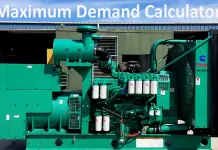



![What is Normally Open & What is Normally Closed [Video Included] What is NO and NC](https://www.electrical4u.net/wp-content/uploads/2020/09/What-is-NO-and-NC-218x150.png)



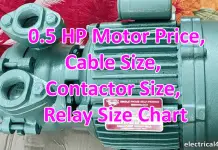
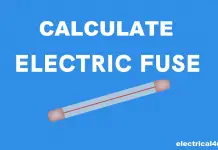

It’s interesting to know that there are circuit breakers that help protect a structure from earth faults. I’m planning to buy a circuit breaker for my workshop soon because I’d like to start buying more heavy equipment someday. That would mean I will also be working with a lot of electricity consumption that could cause problems if I don’t have a circuit breaker for emergency situations.
Nice information, hope to continue learning more